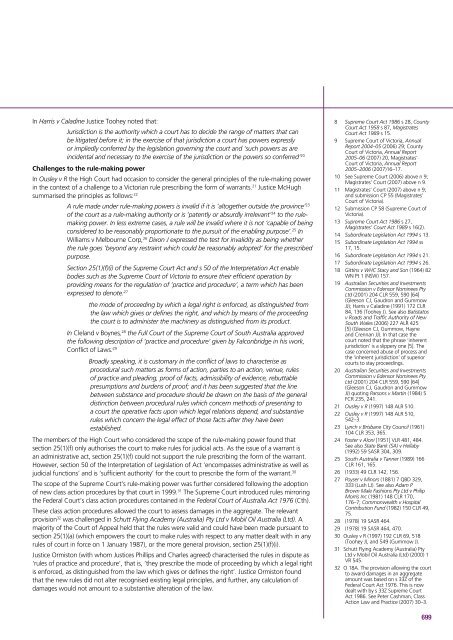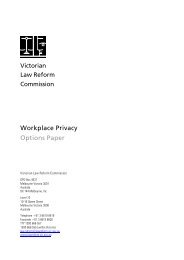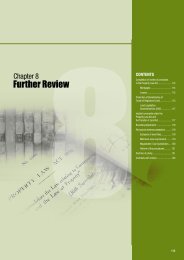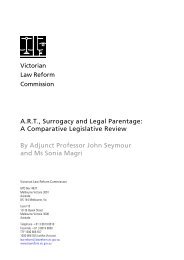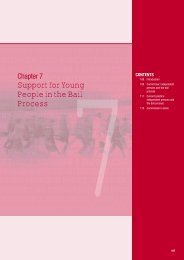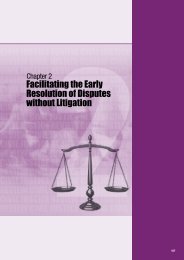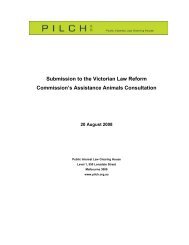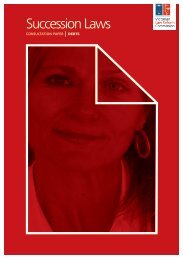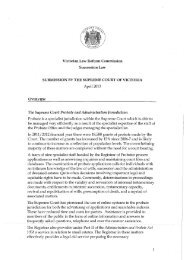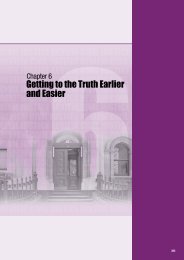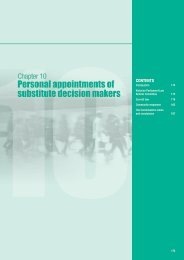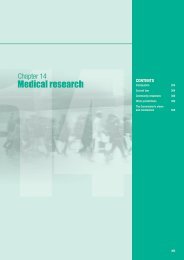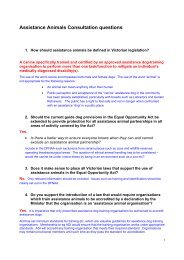12Facilitating Ongoing Civil Justice Review and Reform
12Facilitating Ongoing Civil Justice Review and Reform
12Facilitating Ongoing Civil Justice Review and Reform
Create successful ePaper yourself
Turn your PDF publications into a flip-book with our unique Google optimized e-Paper software.
In Harris v Caladine <strong>Justice</strong> Toohey noted that:<br />
Jurisdiction is the authority which a court has to decide the range of matters that can<br />
be litigated before it; in the exercise of that jurisdiction a court has powers expressly<br />
or impliedly conferred by the legislation governing the court <strong>and</strong> ‘such powers as are<br />
incidental <strong>and</strong> necessary to the exercise of the jurisdiction or the powers so conferred’ 20<br />
Challenges to the rule-making power<br />
In Ousley v R the High Court had occasion to consider the general principles of the rule-making power<br />
in the context of a challenge to a Victorian rule prescribing the form of warrants. 21 <strong>Justice</strong> McHugh<br />
summarised the principles as follows: 22<br />
A rule made under rule-making powers is invalid if it is ’altogether outside the province’ 23<br />
of the court as a rule-making authority or is ’patently or absurdly irrelevant’ 24 to the rulemaking<br />
power. In less extreme cases, a rule will be invalid where it is not ‘capable of being<br />
considered to be reasonably proportionate to the pursuit of the enabling purpose’. 25 In<br />
Williams v Melbourne Corp, 26 Dixon J expressed the test for invalidity as being whether<br />
the rule goes ’beyond any restraint which could be reasonably adopted‘ for the prescribed<br />
purpose.<br />
Section 25(1)(f)(i) of the Supreme Court Act <strong>and</strong> s 50 of the Interpretation Act enable<br />
bodies such as the Supreme Court of Victoria to ensure their efficient operation by<br />
providing means for the regulation of ’practice <strong>and</strong> procedure‘, a term which has been<br />
expressed to denote: 27<br />
the mode of proceeding by which a legal right is enforced, as distinguished from<br />
the law which gives or defines the right, <strong>and</strong> which by means of the proceeding<br />
the court is to administer the machinery as distinguished from its product.<br />
In Clel<strong>and</strong> v Boynes, 28 the Full Court of the Supreme Court of South Australia approved<br />
the following description of ’practice <strong>and</strong> procedure‘ given by Falconbridge in his work,<br />
Conflict of Laws: 29<br />
Broadly speaking, it is customary in the conflict of laws to characterise as<br />
procedural such matters as forms of action, parties to an action, venue, rules<br />
of practice <strong>and</strong> pleading, proof of facts, admissibility of evidence, rebuttable<br />
presumptions <strong>and</strong> burdens of proof; <strong>and</strong> it has been suggested that the line<br />
between substance <strong>and</strong> procedure should be drawn on the basis of the general<br />
distinction between procedural rules which concern methods of presenting to<br />
a court the operative facts upon which legal relations depend, <strong>and</strong> substantive<br />
rules which concern the legal effect of those facts after they have been<br />
established.<br />
The members of the High Court who considered the scope of the rule-making power found that<br />
section 25(1)(f) only authorises the court to make rules for judicial acts. As the issue of a warrant is<br />
an administrative act, section 25(1)(f) could not support the rule prescribing the form of the warrant.<br />
However, section 50 of the Interpretation of Legislation of Act ‘encompasses administrative as well as<br />
judicial functions’ <strong>and</strong> is ‘sufficient authority’ for the court to prescribe the form of the warrant. 30<br />
The scope of the Supreme Court’s rule-making power was further considered following the adoption<br />
of new class action procedures by that court in 1999. 31 The Supreme Court introduced rules mirroring<br />
the Federal Court’s class action procedures contained in the Federal Court of Australia Act 1976 (Cth).<br />
These class action procedures allowed the court to assess damages in the aggregate. The relevant<br />
provision 32 was challenged in Schutt Flying Academy (Australia) Pty Ltd v Mobil Oil Australia (Ltd). A<br />
majority of the Court of Appeal held that the rules were valid <strong>and</strong> could have been made pursuant to<br />
section 25(1)(a) (which empowers the court to make rules with respect to any matter dealt with in any<br />
rules of court in force on 1 January 1987), or the more general provision, section 25(1)(f)(i).<br />
<strong>Justice</strong> Ormiston (with whom <strong>Justice</strong>s Phillips <strong>and</strong> Charles agreed) characterised the rules in dispute as<br />
‘rules of practice <strong>and</strong> procedure’, that is, ‘they prescribe the mode of proceeding by which a legal right<br />
is enforced, as distinguished from the law which gives or defines the right’. <strong>Justice</strong> Ormiston found<br />
that the new rules did not alter recognised existing legal principles, <strong>and</strong> further, any calculation of<br />
damages would not amount to a substantive alteration of the law.<br />
8 Supreme Court Act 1986 s 28, County<br />
Court Act 1958 s 87, Magistrates<br />
Court Act 1989 s 15.<br />
9 Supreme Court of Victoria, Annual<br />
Report 2004–05 (2006) 29; County<br />
Court of Victoria, Annual Report<br />
2005–06 (2007) 20, Magistrates’<br />
Court of Victoria, Annual Report<br />
2005–2006 (2007)16–17.<br />
10 See Supreme Court (2006) above n 9;<br />
Magistrates’ Court (2007) above n 9.<br />
11 Magistrates’ Court (2007) above n 9;<br />
<strong>and</strong> submission CP 55 (Magistrates’<br />
Court of Victoria).<br />
12 Submission CP 58 (Supreme Court of<br />
Victoria).<br />
13 Supreme Court Act 1986 s 27,<br />
Magistrates’ Court Act 1989 s 16(2).<br />
14 Subordinate Legislation Act 1994 s 13.<br />
15 Subordinate Legislation Act 1994 ss<br />
17, 15.<br />
16 Subordinate Legislation Act 1994 s 21.<br />
17 Subordinate Legislation Act 1994 s 26.<br />
18 Gittins v WHC Stacy <strong>and</strong> Son (1964) 82<br />
WN Pt 1 (NSW) 157.<br />
19 Australian Securities <strong>and</strong> Investments<br />
Commission v Edensor Nominees Pty<br />
Ltd (2001) 204 CLR 559, 590 [64]<br />
(Gleeson CJ, Gaudron <strong>and</strong> Gummow<br />
JJ); Harris v Caladine (1991) 172 CLR<br />
84, 136 (Toohey J). See also Batistatos<br />
v Roads <strong>and</strong> Traffic Authority of New<br />
South Wales (2006) 227 ALR 425<br />
[5} (Gleeson CJ, Gummow, Hayne<br />
<strong>and</strong> Crennan JJ). In that case the<br />
court noted that the phrase ‘inherent<br />
jurisdiction’ is a slippery one [5]. The<br />
case concerned abuse of process <strong>and</strong><br />
the ‘inherent jurisdiction’ of superior<br />
courts to stay proceedings.<br />
20 Australian Securities <strong>and</strong> Investments<br />
Commission v Edensor Nominees Pty<br />
Ltd (2001) 204 CLR 559, 590 [64]<br />
(Gleeson CJ, Gaudron <strong>and</strong> Gummow<br />
JJ) quoting Parsons v Martin (1984) 5<br />
FCR 235, 241.<br />
21 Ousley v R (1997) 148 ALR 510.<br />
22 Ousley v R (1997) 148 ALR 510,<br />
542–3.<br />
23 Lynch v Brisbane City Council (1961)<br />
104 CLR 353, 365.<br />
24 Foster v Aloni [1951] VLR 481, 484.<br />
See also State Bank (SA) v Hellaby<br />
(1992) 59 SASR 304, 309.<br />
25 South Australia v Tanner (1989) 166<br />
CLR 161, 165.<br />
26 (1933) 49 CLR 142, 156.<br />
27 Poyser v Minors (1881) 7 QBD 329,<br />
333 (Lush LJ). See also Adam P<br />
Brown Male Fashions Pty Ltd v Philip<br />
Morris Inc (1981) 148 CLR 170,<br />
176–7; Commonwealth v Hospital<br />
Contribution Fund (1982) 150 CLR 49,<br />
75.<br />
28 (1978) 19 SASR 464.<br />
29 (1978) 19 SASR 464, 470.<br />
30 Ousley v R (1997) 192 CLR 69, 518<br />
(Toohey J), <strong>and</strong> 549 (Gummow J).<br />
31 Schutt Flying Academy (Australia) Pty<br />
Ltd v Mobil Oil Australia (Ltd) (2000) 1<br />
VR 545.<br />
32 O 18A. The provision allowing the court<br />
to award damages in an aggregate<br />
amount was based on s 33Z of the<br />
Federal Court Act 1976. This is now<br />
dealt with by s 33Z Supreme Court<br />
Act 1986. See Peter Cashman, Class<br />
Action Law <strong>and</strong> Practice (2007) 30–3.<br />
699


